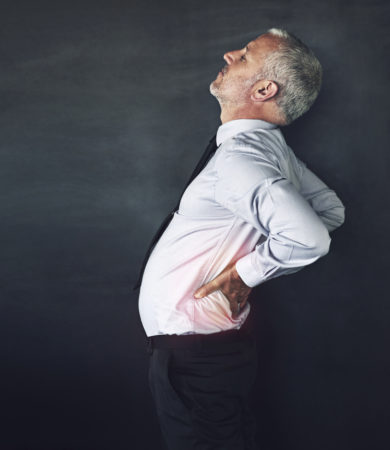Maintaining proper alignment
Heading down the road, it’s natural to settle into your seat, relax and get comfortable for the miles ahead. However, long-term slouching could impact your overall health, since proper posture – in which your bones are aligned properly – allows your nerves, muscles, ligaments, joints, circulation and organs work efficiently without restrictions.
Truck drivers may adopt poor posture habits for a variety of reasons, such as: fatigue, extended driving hours, poorly designed truck seats, improper mattress support in your bunk, excessive weight, too much windshield glare, workplace/traffic stress and inattention to positioning. Be aware that over time, poor driving posture may cause something more serious than a little backache.
A head-forward position may increase your risk of pain in your jaw (TMJ), hands, arms, shoulders, around your eye and headaches. Rounded shoulders can also trigger headaches at the base of your skull, where your shoulder muscles attach. Combining both these head and shoulder positions may lead to constipation, because as your spine arches and sways forward your bowels are able to sag, losing efficiency.
If you permanently adopt a slumped position, your muscles and ligaments will permanently stretch or shorten to accommodate this posture, losing their ability to function normally and limiting your range of motion. As well, your lungs will be unable to fill fully because of the reduced chest cavity space. This will lead to shallow chest-breathing, putting a strain on your lungs, which now have to breathe faster to bring in enough oxygen. As a result, your heart will have to beat faster to provide enough new blood to carry this oxygen, stressing your circulatory system.
In addition, misaligned vertebrae can interfere with your nerve function. When a nerve exiting the spinal column becomes pinched by a misalignment, whatever bodily functions that nerve controls become affected. Misalignments often cause lower back pain, too.
Slouching can even affect your mood. In a recent university study, people who slouched reported increased feelings of depression and lower energy levels compared to people who consciously adopted a more energetic, erect posture. Another recent study from Harvard showed that people who adopted a posture with open shoulders and straight spines increased their testosterone levels by 20% and decreased their cortisol levels by 25%, making them feel physically stronger and less stressed.
To support your healthy posture, throughout the day, become aware of your driving/sitting position and complete some simple exercises, as follows.
Adjust your seat to achieve the best posture support. Set a position where your knees are higher than your hips. Use a small pillow or lumbar device to support the small of your back.
Consciously monitor your posture. Using your mirrors, check to ensure your head is straight, your shoulders are level and you have equal space between your arms and your sides. Avoid sitting on a wallet, or anything else that impacts your body’s balance.
Do neck stretches. Keeping your head centered over your shoulders with your chin directly above your breastbone, extend your head toward the ceiling, while holding your chin parallel to the floor and not lifting it.
Stretch your mid-back. Lift the bottom of your rib-cage an inch or two, pulling your shoulder blades back and down. Practice holding this position for 10-minute intervals.
Practice abdominal breathing. Rest your hand below your belly button; breathe in until you feel your belly expand. Hold for a few seconds. Exhale until your belly is relaxed.
If possible when you leave your rig, loosen your spine with a few fender squats. With your feet together, heels flat and knees apart, hold the front fender of your rig (or another area that can support your weight at similar height) and lean back, trying to get your backside as close to the ground as comfortable/possible. Hold for 20-30 seconds, or until you feel your lower back relax. Repeat.
You can reduce the wear and tear on your health, just take these steps to maintain proper alignment.
***
Karen Bowen is a professional health and nutrition consultant, and she can be reached at karen_bowen@yahoo.com.

Have your say
This is a moderated forum. Comments will no longer be published unless they are accompanied by a first and last name and a verifiable email address. (Today's Trucking will not publish or share the email address.) Profane language and content deemed to be libelous, racist, or threatening in nature will not be published under any circumstances.